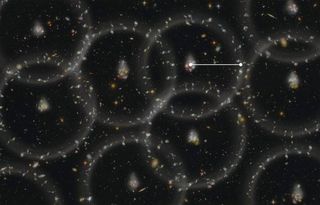Galaxy shapes can help identify wrinkles in space caused by the Big Bang
The new way could also help in better mapping of the universe, scientists say.

Astronomers have found a new way to detect one of the oldest features of our universe.
These Baryon Acoustic Oscillations, or BAO, are subtle wrinkles that flowed through cosmic matter during the first 380,000 years of the universe's existence. Today, they are popular subjects in space science because they're one of the very few hints of the Big Bang that can still be traced — and importantly, astronomers can use the presence of BAOs to measure cosmic distances as well as the rate at which the universe is expanding.
While astronomers have historically focused on galaxy clusters to observe these cosmically imprinted waves, a new study aims to sniff out some overlooked waves by looking at galaxy shapes and orientations rather than just clusters as a whole. These features, the study researchers write, can offer a "promising cosmological probe" yet have been ignored so far.
Related: No, the Big Bang theory is not 'broken.' Here's how we know.
To fill this gap, the team looked at oddities in the orientations of about one million galaxies by studying how stretched those galaxies are. In turn, that revealed the number of nearby galaxies which exert a gravitational pull. Then, researchers zoomed in on galaxies that were not as intensely stretched, which stood out as oddballs in the database.
"It is in those points, where galaxies do not point where they should, where statistics tell us that the Baryon Acoustic Oscillations are located, since these waves also act as points of gravity attraction," Antonio Cuesta, an astrophysicist at the University of Córdoba in Spain and one of the authors of the new study, said in a statement.
As the new way of detecting BAO is quite independent, it helps researchers in measuring the locations of galaxies in the universe and their distances more accurately, according to the study. Ultimately, this knowledge could be used to better map the universe, scientists say.
Get the Space.com Newsletter
Breaking space news, the latest updates on rocket launches, skywatching events and more!
The novel method also reveals more information about the universe's expansion — which is a puzzle in itself because it is accelerating at a rate the scientists can't quite explain. According to the team, the mechanism could also help calculate the amount of the elusive dark matter and dark energy that lies in our universe — the latter of which is actually suspected to be causing space's accelerating expansion somehow.
The new study is not the first effort to detect BAO in the universe. That milestone belongs to two independent teams who spotted the signal in 2005 while analyzing data of nearby galaxies. At the time, the size of BAO signals in the universe was found to be about 150 million parsecs.
One of the goals of the European Space Agency’s Euclid telescope, which launched early July to hunt for dark matter and dark energy, is to measure at least some of these signals across the universe.
Hovering about a million miles (1.6 million km) above Earth, the telescope recently sent home its first starry images.
The paper was published last month in the journal Nature Astronomy.
Join our Space Forums to keep talking space on the latest missions, night sky and more! And if you have a news tip, correction or comment, let us know at: community@space.com.

Sharmila Kuthunur is a Seattle-based science journalist covering astronomy, astrophysics and space exploration. Follow her on X @skuthunur.